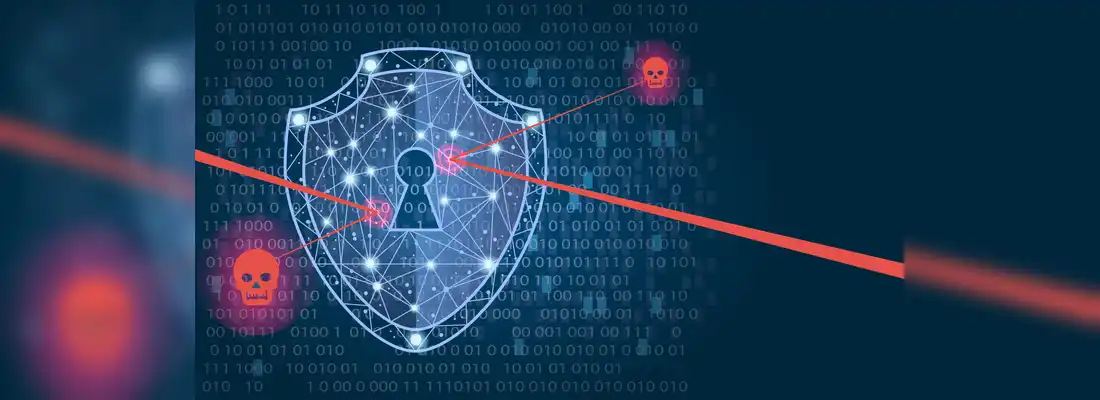Future of Cybersecurity: How Hiring OCR Developers Can Boost Defences
Date: 8 June 2024
.webp?width=550&name=ca969cb5-38db-4762-8b25-8847f1ce8645%20(1).webp)
In a world where cyber threats and data breaches are regular concerns, firms are always looking for creative ways to safeguard their confidential data. Optical Character Recognition (OCR) is one of the many cybersecurity technologies that is available to this end. It is a potent technology that has applications beyond text recognition, such as ID scanning.
A novel method for improving data security, expediting procedures, and guaranteeing compliance is provided by the incorporation of OCR into cybersecurity measures. This article explores the ways in which employing OCR developers may strengthen your cybersecurity defences. They do this by utilising their proficiency in text recognition, software development, and intelligent document processing to produce powerful cybersecurity solutions.
The Role of OCR in Cybersecurity
Optical Character Recognition (OCR) is a technology that involves the conversion of different types of documents, such as scanned paper documents, PDF files, or images captured by a digital camera, into editable and searchable data. The creation of software that can precisely identify and understand text contained in these documents is the area of expertise for OCR developers. Although this technology has historically been used to digitise printed materials, its uses and capabilities go much beyond simple text recognition, and it currently plays a critical part in contemporary cybersecurity tactics.
Organisations can improve their capacity to identify and address any threats, minimise human error, and optimise their data management procedures by automating text recognition and document processing.
How OCR Enhances Security
OCR technology offers several key benefits for cybersecurity including:
- Data Extraction and Analysis: OCR can quickly and accurately extract text from images and various document formats, making it easier to analyse and identify potential security threats. For a deeper understanding of how data extraction tools work, organizations can explore their integration into OCR systems to enhance data analysis capabilities.
- Automated Monitoring: By automating the monitoring of documents and communication channels, OCR helps in the early detection of malicious activities.
- Compliance and Auditing: OCR ensures compliance with data protection regulations by facilitating efficient document auditing and record-keeping.
- Intelligent Document Processing
Intelligent Document Processing (IDP) involves the use of OCR along with artificial intelligence (AI) and machine learning (ML) to process and analyse documents. This advanced approach allows organisations to automate complex document-centric processes, thereby improving accuracy and efficiency.
The Demand for OCR Developers
The increasing reliance on digital documents has led to a growing demand to hire OCR developers or group of developers. These professionals specialize in creating and integrating OCR solutions into existing systems, enhancing an organisation's ability to manage and secure its data through an employee data API. This expertise is crucial for organisations looking to automate their document management processes and enhance their cybersecurity measures.
Market Trends
According to a report by Grand View Research, the global OCR market size was valued at $7.46 billion in 2020 and is expected to grow at a compound annual growth rate (CAGR) of 13.7% from 2021 to 2028. This growth is driven by the increasing adoption of OCR in various industries, including finance, healthcare, and legal services.
The Benefits of Hiring OCR Developers
#1. Expertise in Intelligent Document Processing
OCR developers can build and deploy systems that can handle massive volumes of documents with high accuracy since they have specific expertise in intelligent document processing. For businesses trying to improve their cybersecurity and automate document management procedures, this knowledge is essential. Employing OCR developers offers companies the following advantages:
Enhanced Accuracy: OCR programmers can design systems that reliably identify and comprehend text, lowering the possibility of mistakes and guaranteeing data integrity.
Increased Productivity: By automating document processing jobs, staff members may concentrate on more important projects by saving time and money.
Scalability: Organisations can meet expanding demands without sacrificing security thanks to OCR systems' capacity to scale to handle larger volumes of data.
#2. Strengthening Data Security
Strengthening data security is one of the main benefits of incorporating OCR technology into cybersecurity initiatives. OCR developers can create systems that automatically identify and remove sensitive material, protecting private information. For businesses handling substantial amounts of financial or personal data, this capability is especially crucial. Principal advantages consist of:
Automated Redaction: To lower the possibility of unintentional disclosure, OCR systems have the ability to automatically recognize and redact sensitive information.
Enhanced Auditing: OCR systems enable more efficient auditing and compliance monitoring by generating digital records of all processed documents.
Enhanced Threat Detection: By examining the contents of documents and highlighting questionable patterns or irregularities, OCR technology can assist in locating possible security risks.
#3. Enhancing the Capabilities for Fraud Detection
Another crucial area where OCR technology can have a big influence is fraud detection. OCR programmers can design systems that scan and compare documents for indicators of fraud, like textual errors or formatting changes. For financial institutions, insurance providers, and other businesses that are regularly the targets of fraud, this feature can be extremely helpful. Advantages consist of:
Early Detection: Organisations can take action before major damage is done by using OCR technologies, which can immediately recognize symptoms of fraud.
Full Analysis: OCR systems offer a full perspective of potential hazards by evaluating documents in real-time, which facilitates better decision-making.
Decreased Human Error: By automating fraud detection, the chance of human error is decreased, guaranteeing that such risks are recognized and dealt with right away.
Practical Applications of OCR in Cybersecurity
The integration of OCR technology in cybersecurity practices can be seen in several practical applications:
Verification and Authentication of papers: Using optical character recognition (OCR), one may confirm the legitimacy of papers including contracts, driver's licenses, and passports. Through the use of databases or established patterns, OCR aids in the identification of forged papers.
Email security: Phishing attacks frequently use phony emails that look authentic. Before phishing efforts reach the intended recipient, OCR can detect and stop them by scanning email content and attachments for questionable text patterns.
Safe Data Storage: By enabling the secure digitalisation of paper documents, OCR technology lowers the possibility of physical document loss or theft. These papers can be digitally saved with access controls and encryption for safekeeping.
Real-Time Threat Detection: OCR systems can be integrated with security software to provide real-time monitoring and threat detection. For instance, OCR can scan and analyse incoming data for signs of cyber threats, such as malware code embedded in images or PDFs.
Essential Considerations When Hiring OCR Developers
When seeking to hire OCR developers, there are several factors to consider to ensure you find the right talent for your needs:
#1. Technical Skills
- Proficiency in Programming Languages: Look for developers skilled in languages commonly used for OCR development, such as Python, C++, and Java. Some roles will require specific knowledge of CRMs or ERPs, like cases when a developer is required to work with Salesforce OCR.
- Experience with Machine Learning: Developers should have a strong understanding of ML algorithms and how they can be applied to improve OCR accuracy.
- Knowledge of Text Recognition Technologies: Ensure that candidates have experience with the latest text recognition tools and techniques.
#2. Industry Experience
- Relevant Sector Experience: Consider developers who have experience working in your specific industry, whether it's finance, healthcare, or legal services.
- Proven Track Record: Look for candidates with a history of successfully implementing OCR solutions that have demonstrably improved data security and processing efficiency.
#3. Soft Skills
- Problem-Solving Abilities: OCR developers should be adept at identifying and solving complex technical challenges.
- Attention to Detail: Precision is crucial in OCR development to ensure accurate text recognition and the effective functioning of data extraction software.
- Communication Skills: Effective communication is essential for collaborating with other team members and stakeholders.
The Future of OCR in Cybersecurity
OCR is projected to play an increasingly important role in data protection as cybersecurity risks continue to change. Future developments in OCR technology are probably going to concentrate on enhancing speed, accuracy, and compatibility with other cybersecurity tools.
- Future Developments: AI-Driven OCR: By combining AI and OCR, this technology will be better able to learn and adjust to new document formats and languages, thereby enhancing overall performance.
- Integration with Blockchain: By combining OCR and blockchain technology, an extra degree of security might be added, guaranteeing the validity and integrity of digitized documents.
- Improved Privacy Protections: Data privacy will be given top priority in future OCR systems, which will use sophisticated encryption and anonymisation methods to safeguard private data.
Real-World Impact: Statistics and Case Studies
Financial Sector
In the financial industry, the implementation of OCR technology has led to significant improvements in data processing and security. According to a report by Forbes, financial institutions that adopted OCR solutions saw a 30% reduction in document processing time and a 25% decrease in data entry errors.
Healthcare Industry
The healthcare sector has also benefited from OCR technology. Hospitals using OCR for patient record management experienced a 20% increase in data retrieval speed and a 15% improvement in data accuracy, leading to better patient care and reduced administrative costs.
Legal Services
Law firms that have integrated OCR into their document management systems report significant efficiency gains. According to a survey by Statista, 40% of legal professionals stated that OCR technology helped them reduce the time spent on document searches by half, enabling them to focus more on client service and case preparation.
To visually illustrate the benefits of OCR technology in cybersecurity, consider the following stats:
- 30% reduction in document processing time in the financial sector.
- 20% increase in data retrieval speed in healthcare.
- 40% reduction in document search time in legal services.
- 25% decrease in data entry errors across industries.
Conclusion
The integration of OCR technology into cybersecurity strategies represents a significant breakthrough in the fight against cyberthreats. By hiring OCR experts, companies may leverage intelligent document processing and sophisticated text recognition to improve fraud detection, strengthen data security, and speed up compliance processes.
As the digital landscape evolves, OCR technology will become increasingly significant in cybersecurity and will be an essential component of any comprehensive cybersecurity plan. Embrace the future of cybersecurity by investing in OCR developers and unleashing the full potential of this cutting-edge technology to protect your business from new threats.








-1.webp)
